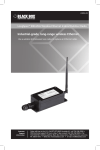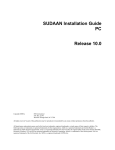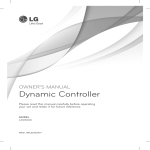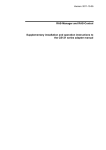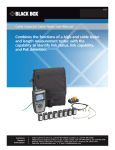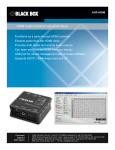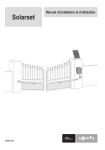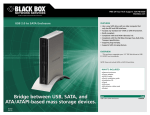Download Black Box Tech Support: FREE! Live. 24/7. Tech support the way it
Transcript
Black Box Tech Support: FREE! Live. 24/7. Tech support the way it should be. Great tech support is just 20 seconds away at 724-746-5500 or blackbox.com. About Black Box Black Box Network Services is your source for more than 118,000 networking and infrastructure products. You’ll find everything from cabinets and racks and power and surge protection products to media converters and Ethernet switches all supported by free, live 24/7 Tech support available in 20 seconds or less. © Copyright 2009. All rights reserved. 724-746-5500 | blackbox.com July 2009 LS900-TUBE-KIT LongSpan 900-MHz Wireless Ethernet Tube Housing Kit Industrial-grade, long-range wireless Ethernet. BLACK BOX Includes (1) indoor/outdoor tube housing with integrated 900-MHz ® wireless radio assembly, (1) wireless radio (LS900A) for the other end of the link, (2) 2.5-omnidirectional antennas, (2) power supplies, and (1) PoE mid-span power injector. Works with Sony IPELA Fixed IP Camera (SNC-CS50) (ordered separately). Customer Support Information Order toll-free in the U.S.: Call 877-877-BBOX (outside U.S. call 724-746-5500) • FREE technical support 24 hours a day, 7 days a week: Call 724-746-5500 or fax 724-746-0746 • Mailing address: Black Box Corporation, 1000 Park Drive, Lawrence, PA 15055-1018 • Web site: www.blackbox.com • E-mail: [email protected] FCC and IC RFI Statements FEDERAL COMMUNICATIONS COMMISSION AND INDUSTRY CANADA RADIO FREQUENCY INTERFERENCE STATEMENTS This equipment generates, uses, and can radiate radio-frequency energy, and if not installed and used properly, that is, in strict accordance with the manufacturer’s instructions, may cause interference to radio communication. It has been tested and found to comply with the limits for a Class A computing device in accordance with the specifications in Subpart B of Part 15 of FCC rules, which are designed to provide reasonable protection against such interference when the equipment is operated in a commercial environment. Operation of this equipment in a residential area is likely to cause interference, in which case the user at his own expense will be required to take whatever measures may be necessary to correct the interference. Changes or modifications not expressly approved by the party responsible for compliance could void the user’s authority to operate the equipment. This digital apparatus does not exceed the Class A limits for radio noise emission from digital apparatus set out in the Radio Interference Regulation of Industry Canada. Le présent appareil numérique n’émet pas de bruits radioélectriques dépassant les limites applicables aux appareils numériques de la classe A prescrites dans le Règlement sur le brouillage radioélectrique publié par Industrie Canada. Normas Oficiales Mexicanas (NOM) Electrical Safety Statement INSTRUCCIONES DE SEGURIDAD 1.Todas las instrucciones de seguridad y operación deberán ser leídas antes de que el aparato eléctrico sea operado. 2.Las instrucciones de seguridad y operación deberán ser guardadas para referencia futura. 3.Todas las advertencias en el aparato eléctrico y en sus instrucciones de operación deben ser respetadas. 4.Todas las instrucciones de operación y uso deben ser seguidas. 724-746-5500 | blackbox.com Page 1 LongSpan 900-MHz Wireless Ethernet Tube Housing Kit 5. El aparato eléctrico no deberá ser usado cerca del agua—por ejemplo, cerca de la tina de baño, lavabo, sótano mojado o cerca de una alberca, etc.. 6. El aparato eléctrico debe ser usado únicamente con carritos o pedestales que sean recomendados por el fabricante. 7. El aparato eléctrico debe ser montado a la pared o al techo sólo como sea recomendado por el fabricante. 8. Servicio—El usuario no debe intentar dar servicio al equipo eléctrico más allá lo descrito en las instrucciones de operación. Todo otro servicio deberá ser referido a personal de servicio calificado. 9. El aparato eléctrico debe ser situado de tal manera que su posición no interfiera su uso. La colocación del aparato eléctrico sobre una cama, sofá, alfombra o superficie similar puede bloquea la ventilación, no se debe colocar en libreros o gabinetes que impidan el flujo de aire por los orificios de ventilación. 10. El equipo eléctrico deber ser situado fuera del alcance de fuentes de calor como radiadores, registros de calor, estufas u otros aparatos (incluyendo amplificadores) que producen calor. 11. El aparato eléctrico deberá ser connectado a una fuente de poder sólo del tipo descrito en el instructivo de operación, o como se indique en el aparato. 12. Precaución debe ser tomada de tal manera que la tierra fisica y la polarización del equipo no sea eliminada. 13. Los cables de la fuente de poder deben ser guiados de tal manera que no sean pisados ni pellizcados por objetos colocados sobre o contra ellos, poniendo particular atención a los contactos y receptáculos donde salen del aparato. 14. El equipo eléctrico debe ser limpiado únicamente de acuerdo a las recomendaciones del fabricante. 15. En caso de existir, una antena externa deberá ser localizada lejos de las lineas de energia. 16. El cable de corriente deberá ser desconectado del cuando el equipo no sea usado por un largo periodo de tiempo. Page 2 724-746-5500 | blackbox.com NOM Statement 17. Cuidado debe ser tomado de tal manera que objectos liquidos no sean derramados sobre la cubierta u orificios de ventilación. 18. Servicio por personal calificado deberá ser provisto cuando: A: El cable de poder o el contacto ha sido dañado; u B: Objectos han caído o líquido ha sido derramado dentro del aparato; o C: El aparato ha sido expuesto a la lluvia; o D: El aparato parece no operar normalmente o muestra un cambio en su desempeño; o E: El aparato ha sido tirado o su cubierta ha sido dañada. 724-746-5500 | blackbox.com Page 3 LongSpan 900-MHz Wireless Ethernet Tube Housing Kit TRADEMARKS USED IN THIS MANUAL Black Box and the Double Diamond logo are registered trademarks of BB Technologies, Inc. Mac is a registered trademark of Apple Computer, Inc. Linux is a registered trademark of Linus Torvalds. Microsoft and Windows are registered trademarks of Microsoft Corporation. Wi-Fi is a registered trademark of the Wi-Fi Alliance. Any other trademarks mentioned in this manual are acknowledged to be the property of the trademark owners. Page 4 724-746-5500 | blackbox.com Table of Contents Chapter Page 1. Specifications.................................................................................................6 2. Overview.......................................................................................................7 2.1 Introduction..........................................................................................7 2.2 What’s Included....................................................................................7 2.3 About the Technology..........................................................................7 2.4 Typical Application................................................................................9 3. Components................................................................................................10 3.1 Radio/Extender...................................................................................10 3.2 Housing with Radio, Power Supply, Heater, and Blower Installed....... 11 3.3 Tube Camera (Ordered Separately) with Housing . ............................ 11 3.4 Overview of Products Combined........................................................ 11 4. Installation................................................................................................... 12 4.1 Connecting the Radio and Power Supply........................................... 12 4.2 Installing the Housing......................................................................... 13 4.3 Installing a Sony SNC-CS50 Camera (Not Included) into the Housing................................................................................. 13 4.4 Wiring................................................................................................. 15 4.5 Mounting the Housing....................................................................... 17 4.6 Connecting the Standalone Radio or Radios.......................................19 5. Configuring the Radio....................................................................................20 5.1 Digital Setup.......................................................................................20 5.2 Physical Setup.....................................................................................24 6. Installing and Adjusting the Antennas.........................................................25 Appendix. Troubleshooting.................................................................................29 A.1 Problems/Solutions.............................................................................29 A.2 Calling Black Box.................................................................................29 A.3 Shipping and Packaging......................................................................29 724-746-5500 | blackbox.com Page 5 LongSpan 900-MHz Wireless Ethernet Tube Housing Kit 1. Specifications Camera: Sony IPELA Fixed IP Camera (SNC-CS50), ordered separately Distance: LS900A: 40 miles line of sight with 15-dBi antenna Environmental: Operating temperature: -40 to +158° F (-40 to +70° C) Radio Channels/Bandwidth: LS900A: 12 non-overlapping with 2.0833-MHz spacing and 1.75-MHz occupied bandwidth Radio Link Budget: LS900A: 148 dB with 15 dBi antenna Receive Sensitivity: LS900A: -97 dBm at 10e-4 BER (-112 dBm with 15-dBi antenna) Speed: LS900A: RF Transmission Rate: 1.536 Mbps; Ethernet Throughput: 935 kbps Connectors: LS900A: (1) RJ-45 PoE 10BASE-T/100BASE-TX Indicators: LS900A: LEDs: (1) Power, (1) Ethernet Link, (1) RF RX, (1) RF TX, (4) Channel, (6) Link Quality Power: LS900A, LS900PKA: From 110-VAC, 60 Hz external power adapter or PoE injector Size: LS900A: Each radio: 2"H x 6.7"W x 3.1"D (5 x 17 x 8 cm); LS900-TUBE-HSE: 15.4"H x 5.7"W x 15.8"D (39 x 14.4 x 40 cm); Maximum camera length: 10.5" (26.7 cm) Weight: 4 lb. (1.8 kg) Page 6 724-746-5500 | blackbox.com Chapter 2: Overview 2. Overview 2.1 Introduction The Long-Span Tube Housing Kit is a complete indoor/outdoor camera/wireless radio to wireless radio solution in a weather-proof enclosure. It helps you create a long-range, wireless Ethernet network with up to 16 subscriber units per access point. The kit includes (1) indoor/outdoor tube housing with integrated 900-MHz wireless radio assembly, (1) wireless radio (LS900A) for the other end of the link, (2) 2.5-dBi omnidirectional antennas, (2) power supplies, and (1) PoE mid-span power injector. It works with the Sony IPELA Fixed IP Camera (SNC-CS50), which is ordered separately. This manual contains instructions for installing the camera. You can combine it with LS900A or LS900PKA (Integrated Radio and Directional Antenna). This user’s manual tells you how to set up your system, and also describes how each component of the system operates. When you receive your kit, the radio circuit board, heater/blower, and power supply are already installed in the tube housing. You will need to install the camera (ordered separately) yourself—complete instructions appear in Section 4.3 of this manual. 2.2 What’s Included Your package should include the following items. If anything is missing or damaged, please contact Black Box Technical Support at 724-746-5500. • (1) indoor/outdoor tube housing with integrated 900-MHz wireless radio assembly • (1) wireless radio (LS900A) for other end of link • (2) 2.5-dBi omnidirectional antennas • (2) power supplies • (1) PoE mid-span power injector • This user’s manual 2.3 About the Technology The LongSpan 900-MHz Wireless Ethernet System replaces a continuous Ethernet cable connection to provide wireless data transmission in the unlicensed 900-MHz frequency spectrum. For example, in a wireless Ethernet network, the end user relies on a system of unmanned networked radios, computers, servers, and surveillance cameras to provide data and graphics transmission. 724-746-5500 | blackbox.com Page 7 LongSpan 900-MHz Wireless Ethernet Tube Housing Kit Other technologies, such as Wi-Fi®, don’t support the long-range distance capability of the 900-MHz system. Wi-Fi delivers a large amount of data over short distances and is great for real-time applications. Since it’s a broad-spectrum technology that relies on a licensed band of wireless transmission, Wi-Fi is frequency stagnant. Your grandparents or great-grandparents might have had a party-line phone back in the 1930s. Similar to a party-line phone, Wi-Fi shares a broad-range frequency spectrum between several users. In contrast, the Long-Span 900-MHz Wireless Ethernet System operates over an unlicensed wireless radio band. Several advantages for using the 900-MHz frequency exist. First, this narrow-band frequency is ideal for low-speed, long-distance Ethernet data transmission. Next, it’s thermally sustainable at high temperatures. And since it’s a virtual Ethernet connection, you don’t have the hassle of installing a large wiring infrastructure. A LongSpan wireless Ethernet uplink runs at a speed of up to 1 Mbps. If you don’t think that is fast enough for low-data rate applications, just consider that the uplink speed on a typical DSL line is 38.4 kbps, well within the 1-Mbps limit for LongSpan. The LongSpan system works in applications where the data rate requirement is low. For example, it can be used in docking stations for a fleet of buses. At the docking station, data can be transmitted to a media player in a digital signage system. The data is stored in a buffer, then narrowcasted to digital screens on buses. Other applications include providing links for an audio paging system at a golf course, campground, campus, or mall. The LongSpan system features: • long-range reach (up to 40+ miles) • robust operation • industrial grade (operates at -40 to 160° F) • easy installation • fast enough speed (up to 1 Mbps) • affordability (costs less than $2000) Page 8 724-746-5500 | blackbox.com Chapter 2: Overview 2.4 Typical Application Antenna RF-TNC connector Power cable RJ-45 cable Tube housing Camera lens Radio board Antenna Wireless radio 10BASE-T Power board data cable (on top) Camera installed Heater Camera sled Power in Power to 24 VDC to 24 VAC back of power converter camera 110-VAC power plug Power and data CAT5e cable, outdoor grade, 300 ft. (50 m) maximum Power over Ethernet injector Ethernet RJ-45 connector Blower/fan (underneath power board) Figure 2-1. Application. 724-746-5500 | blackbox.com Page 9 LongSpan 900-MHz Wireless Ethernet Tube Housing Kit 3. Components The Long-Span 900-MHz Wireless Ethernet Tube Housing Kit components are illustrated below. 3.1 Radio/Extender The radio/extender board installed in the tube housing is our LS900A. It operates the same as the standlone model (see Chapter 5). Figure 3-1 shows the radio board. Radio board RJ-45 network connector (links radio board to camera) Power connector Figure 3-1. Close-up of radio board with cable connections. Page 10 724-746-5500 | blackbox.com Chapter 3: Components 3.2 Housing with Radio, Power Supply, Heater, and Blower Installed The radio arrives already installed in the tube housing. Figure 3-2 shows the tube housing with radio installed. Heater Camera goes here (not installed yet) Radio board Power board (blower is underneath power board) Figure 3-2. Housing configuration as shipped. 3.3 Tube Camera (Ordered Separately) with Housing The camera (not included) installs in the tube housing. Figure 4-1 shows the tube housing with camera installed. 3.4 Overview of Products Combined Figure 2-1 shows the complete system with all components installed. 724-746-5500 | blackbox.com Page 11 LongSpan 900-MHz Wireless Ethernet Tube Housing Kit 4. Installation 4.1 Connecting the Radio and Power Supply Figure 4-1 shows the inside of the enclosure. The 900-MHz radio, power supply, and heater/blower are already installed. Antenna Tube housing Ethernet Power (RJ-45) cable cable Power board (on top) Radio board Camera lens Camera installed Heater Camera sled Power to back of camera Blower/fan (underneath power board) 24 VDC to 24 VAC power converter Power in Figure 4-1. Installation diagram, side view. You will need to make a few simple connections between the components: 1. Connect one end of the Ethernet cable to the radio board. 2. Connect one end of the power cable to the radio board. 3. Connect the RF reverse-polarity (rubber ducky) antenna. 4. Install the camera as described in Section 4.3. Page 12 724-746-5500 | blackbox.com Chapter 4: Installation 4.2 Installing the Housing 1. Remove two panhead screws on top of front and back endcaps of the housing, then lift the top over the housing to its full span position. 2. From the outside, insert a cable strain relief plug into one of the two holes located on the bottom rear of the housing. Screw a black nylon locknut onto the cable strain relief plug from the inside of the housing and tighten. Repeat for the other plug. OPTION: Omit one or both cable strain relief plugs if 1⁄2" metal conduit is used in the cable entry holes. 4.3 Installing a Sony SNC-CS50 Camera (Not Included) into the Housing 1. To loosen the camera sled, turn the panhead screw located on the inside ledge of the bottom half of the housing 1⁄2 turn counterclockwise. Slide the camera sled toward the rear of the housing until the screw head is aligned with the hole on the key slot of the camera sled. Lift and remove. Sled screw Camera sled Figure 4-2. Removing the camera sled. 724-746-5500 | blackbox.com Page 13 LongSpan 900-MHz Wireless Ethernet Tube Housing Kit 2. Place the camera/lens on the camera sled. Align the mount hole of the camera with the slot in the camera sled. Insert a bolt through the slot on the bottom of the sled into the camera. Adjust the camera so that it is parallel with the sled and tighten bolt. 3. Place the sled leg of the completed camera sled assembly into the channel on the bottom of the housing. Adjust the camera sled until the key slot hole aligns with the panhead screw. Make sure the camera is seated properly. Slide the camera sled forward to the desired position. Tighten the screw to secure the camera. Camera lens Camera sled Sled screw Camera Tube housing Antenna connector Power board Figure 4-3. Camera installed in housing. Page 14 724-746-5500 | blackbox.com Chapter 4: Installation 4.4 Wiring 1. Feed wiring/cable through the cable strain reliefs on the bottom of the housing until the desired amount of wire has entered the housing. Make wiring connections to the camera and lens as required by the manufacturer. Camera (installed) Power connector RJ-45 network connector (links radio board to camera) Radio board Power board with wires connected Figure 4-4. Wiring connections. 2. Turn the cable strain reliefs to tighen down on the wiring cable. WARNING: A readily accessible disconnect device should be incorporated in the fixed wiring. 724-746-5500 | blackbox.com Page 15 LongSpan 900-MHz Wireless Ethernet Tube Housing Kit A plug-in wall transformer is included with the housing. The transformer outputs 24 VAC. Determine where the transformers will be located, then run a set of power wires into the cable strain relief. Use the chart below to determine the correct wire gauge needed based on the length of the run. Table 4-1. 24-VAC wiring distances. 22 20 28 Total VA 35 44 70 Consumed Wire Gauge 16 14 112 179 12 285 10 452 1. Run 24-VAC power through a cable strain relief (separate from the Ethernet). Place stripped power wire ends into the power board terminals marked 24 AC (in). 2. Secure the ground wire to the screw located in the bottom rear of housing. 3. Tighten the terminal block screws, then tighten the cable strain relief. 24-VAC Blower Blower Heater 24 VAC (IN) (camera) (black) (red) Figure 4-5. Terminal block connections. 4. Connect the Ethernet (RJ-45) cable from the wireless unit to the network camera See Figure 4-1. Page 16 724-746-5500 | blackbox.com Chapter 4: Installation 4.5 Mounting the Housing To pole mount: 1. Position the bracket assembly at the desired height and location on the pole. See Figure 4-6. Bracket Pole Figure 4-6. Positioning the bracket on a pole. 2. Attach the assembly to the pole using 3⁄4" mounting straps (not included). 3. Slide the mounting straps through the slots in the bracket and tighten to the pole (see Figure 4-7). Mounting straps Pole Bracket Figure 4-7. Securing the bracket to the pole with mounting straps. 724-746-5500 | blackbox.com Page 17 LongSpan 900-MHz Wireless Ethernet Tube Housing Kit To wall mount: 1. Remove the tilt mechanism from the bracket and attach it to the housing mounting holes using (2) 1⁄4-20 x 1⁄2" bolts with lock washers. 2. Hold the bracket to the wall and mark the bracket mounting pattern. Using the appropriate hardware and methods, secure the bracket to the wall. 3. After securing the bracket to the wall, take the camera housing and align the tilt mechanism. Insert the 1⁄4-20 x 5⁄8" bolts into the holes and finger tighten. Figure 4-8. Aligning the housing’s tilt mechanism. 4. Adjust the camera to the desired position and tighten the bolts to prevent camera housing movement. See Figure 4-9. Tighten bolts Figure 4-9. Tighten bolts. Page 18 724-746-5500 | blackbox.com Chapter 4: Installation 4.6 Connecting the Standalone Radio or Radios At the other end of the link, you will install the second (standalone) radio that’s included with your kit. Refer to Figure 4-10 and follow the steps below. Antenna RF-TNC connector Wireless radio Power and data CAT5e cable, outdoor grade, 300 ft. (50 m) maximum 110-VAC power plug Power over Ethernet injector Ethernet RJ-45 connector 10BASE-T data cable Figure 4-10. Installing the standalone radio (Included) at the other end. of the wireless Ethernet link. 1.Using CAT5e cable, connect the power injector (included) to the radio. 2. Using an RJ-45 CAT5e cable, attach the other end of the power injector to the Ethernet network. Then connect the power plug to the included universal power supply (90–264 VAC). 3. Following the instructions in Section 5.2, mount the radio to a pole or the side of a building. 724-746-5500 | blackbox.com Page 19 LongSpan 900-MHz Wireless Ethernet Tube Housing Kit 5. Configuring the Radio 5.1 Digital Setup 1. The radio’s built-in browser interface enables you to configure it digitally. 2. Download the Black Box Discovery Utility from our Web site: http://www.blackbox.com/go/LongSpan/LongSpan_Finder This link will prompt you to either Run or Save the application. Press Run to start it immediately; press Save to save the application before running. NOTE: T his utility only runs on Microsoft® Windows®, not Linux® or Mac®. If you must use a non Windows computer for configuration, make sure your subnet mask allows your computer to see 192.168.1.17. Connect to that default IP address with your Web browser, continuing the setup procedure with Step 6. 3. Run the IP Discovery Utility, ipfinder.exe and you should see a window similar to Figure 5-1. Figure 5-1. IP Discovery screen. Page 20 724-746-5500 | blackbox.com Chapter 5: Configuring the Radio The LS900A should appear in the list as the default address of 192.168.1.17. If it does not, click “Search” to regenerate the list. If it still does not appear, either you might have a connection issue and need to re-examine the cabling, or you might have a firewall issue on your computer. 4.Double-click the item in the list that refers to the radio being configured. You will see a second window similar to Figure 5-2. Figure 5-2. Radio IP Configuration screen. The information on the left in Figure 5-2 is the current status of the radio; the boxes on the right allow you to change it. Make sure that the radio’s IP address is in the same subnet as your computer. For example, if the subnet mask is 255.255.255.0 (a class C network), the first three number groups of the IP address must match. Choose your desired parameters and click “Apply.” 5.Write down the IP address and password you just chose, then click “Go to Device Web Page.” Your default Web browser will launch with the device IP address in the browser address bar. Or, you may launch the browser on your own and enter the Web page address manually: http://[the IP address you just set]. 724-746-5500 | blackbox.com Page 21 LongSpan 900-MHz Wireless Ethernet Tube Housing Kit 6. The browser page that loads first shows the current device information and QoS statistics and provides a login at the upper right. Log in using the password you just specified (or “password” if you kept the default). If the login is successful, you will see the Admin page similar to Figure 5-3. Figure 5-3. Admin page. 7. This page has sections similar to the login page showing radio statistics and device information plus it adds several new sections. The Device Settings section allows you to set the network information and choose an RF frequency channel. The default is to allow the radio to choose its own frequency based on minimizing interference. If you set a fixed channel, make sure the AP and all SUs use the same one. References to DIP switches on this and the next Web page refer to switches inside the radio that are used in the legacy method of configuration. You may ignore the DIP switches when using the Web browser method. Page 22 724-746-5500 | blackbox.com Chapter 5: Configuring the Radio If you scroll down in the Admin browser page, you will come to three more sections: • A graphical spectrum analyzer display that may help you select radio channels that avoid interference. • A section you will use to update the radio’s firmware. • An advanced links section with a warning that it’s for advanced users only. Despite the warning, you will need to click the “Advanced Admin” button to set the device type, ID, and encryption key. You will then see a page similar to Figure 5-4. Figure 5-4. Advanced admin page. 8.On the Advanced Admin page, set the parameters as follows: • Choose Device Type: Access Point or Subscriber Unit. • For an AP, enter the number of SUs that will be communicating with it. • For SUs, assign unique ID numbers in numeric order from 1 to 63. • Click the box labeled “Enabled User Specified Keys.” 724-746-5500 | blackbox.com Page 23 LongSpan 900-MHz Wireless Ethernet Tube Housing Kit • Choose an 8-digit hex (0–9 and A–F) Network Name that will be common among the AP and the SUs and enter it. The hyphen is required. • Choose a 32-digit hex Encryption Key and enter it. Again, the hyphens are required. This key must match between the AP and the SU. Write down the key. After entering the parameters, click the “Apply” button to save them to the radio. 9. When all the radios are keyed and operating, connect them to your network and Ethernet devices as desired and cycle the radio’s power to begin normal operation. You can manage the SUs via a browser over the wireless network. NOTE: Do not plug actively linked radios into the same switch because this will corrupt its routing table and may cause network problems just as if you plugged a CAT5 cable directly between two ports of a switch. 5.2 Physical Setup 1. Before mounting the radio in its final location, follow the digital setup instructions in Section 5.1. 2. Mount the radio securely. Maximize lightning resistance by providing a strong DC ground connection to the metal housing. 3. Connect the radio’s TNC RF connector to a suitable antenna. A simple omnidirectional dipole unit is included—you can use this antenna for testing and for relatively undemanding applications. If your application requires greater distance and/or a wider range of direction, choose either the LongSpan Long-Distance 900-MHz Directional 15-dBi Yagi antenna (LS900-15Y) or the LongSpan Medium-Range 900-MHz Omnidirectional 5-dBi antenna (LS900-5M). 4. The unit receives power via an Ethernet cable, so you can place the power supply in a convenient location. The included Power over Ethernet injector (PoE) enables you to add DC power to unused wires in the cable. Decide where to place the PoE based on its proximity to AC power at some point along the desired path of the Ethernet cable. Plug the included power supply into an appropriate electrical outlet and into the PoE. Connect an Ethernet cable between your network and the “DATA IN” port on the PoE. Connect a second cable from the “P + DATA OUT” port on the PoE and the radio. The radio has a cable clamping device that allows an RJ-45 plug on the cable to pass through it. Page 24 724-746-5500 | blackbox.com Chapter 6: Installing and Adjusting the Antennas You can then tighten the cable clamping device around the cable to provide a weatherproof seal. 6. Installing and Adjusting the Antennas Before you install your wireless antenna, follow a few basic rules. All antennas have a polarity. The antenna could have horizontal polarity or vertical polarity. Figure 6-1 illustrates the difference between the two polarizations with a 2.5-dBi antenna and an 11-dBi antenna. Vertical polarization 2.5-dBi antenna 11-dBi antenna Tube housing Horizontal polarization 2.5-dBi antenna Tube housing 11-dBi antenna Figure 6-1. Antenna diagram #1. 724-746-5500 | blackbox.com Page 25 LongSpan 900-MHz Wireless Ethernet Tube Housing Kit Figure 6-2 shows some correct and incorrect methods of aligning the antennas. The 2.5-dBi antenna is considered omnidirectional. They are designed so the radio wave will project out from the sides of the antennas. The radio wave patterns will resemble a doughnut. Because of this pattern, never try to point the ends of the antennas directly toward one another or directly away from one another. WRONG! Do not aim the 2.5-dBi antennas directly at each other. 2.5-dBi omnidirectional antenna 2.5-dBi omnidirectional antenna RIGHT 2.5-dBi omnidirectional antenna 2.5-dBi omnidirectional antenna RIGHT Figure 6-2. Antenna diagram #2. Page 26 724-746-5500 | blackbox.com Chapter 6: Installing and Adjusting the Antennas 2.5-dBi omnidirectional antenna WRONG 2.5-dBi omnidirectional antenna 2.5-dBi omnidirectional antenna 2.5-dBi omnidirectional antenna RIGHT Figure 6-3. Antenna diagram #3. The 11-dBi antennas are directional. They are designed so the radio wave will project directly out the front of the antenna. Because of this, you should always point the 11 dBi antennas direcly at each other and never point them away from each other. For a maximum range point-to-point (one unit), we recommend using the auto-channel selection mode and a maximum gain of 11 dBi. 724-746-5500 | blackbox.com Page 27 LongSpan 900-MHz Wireless Ethernet Tube Housing Kit 11-dBi antenna 11-dBi antenna RIGHT 11-dBi antenna 11-dBi antenna RIGHT 11-dBi antenna 11-dBi antenna WRONG 11-dBi antenna WRONG 11-dBi antenna Figure 6-4. Antenna diagram #4. Page 28 724-746-5500 | blackbox.com Appendix: Troubleshooting Appendix. Troubleshooting A.1 Problems/Solutions Problem: No power LED. Solution: Check the power connections. Problem: No radio link. Solution: The radio is looking for its matched partner. If both units are powered on and the Power LEDs are active, they may be too far away to create the radio connection. Try other locations to get the best range when they are oriented to point directly at each other with antenna elements oriented in the same plane (i.e., vertically or horizontally). Problem: Radio link on but quality indicator is low. Solution: The units may be too far away from each other to create a good radio connection. Try other locations that may have a less obstructed path, or try reorienting the antennas. Problem: Ethernet LED is not lit. Solution: Check your network connections. A.2 Calling Black Box If you determine that your Long-Span Tube Housing Kit is malfunctioning, do not attempt to alter or repair the unit. It contains no user-serviceable parts. Contact Black Box Technical Support at 724-746-5500. Before you do, make a record of the history of the problem. We will be able to provide more efficient and accurate assistance if you have a complete description, including: • the nature and duration of the problem. • when the problem occurs. • the components involved in the problem. • any particular application that, when used, appears to create the problem or make it worse. A.3 Shipping and Packaging If you need to transport or ship your Long-Span Tube Housing Kit: • Package it carefully. We recommend that you use the original container. • If you are returning the unit, make sure you include everything you received with it. Before you ship for return or repair, contact Black Box to get a Return Authorization (RA) number. 724-746-5500 | blackbox.com Page 29































